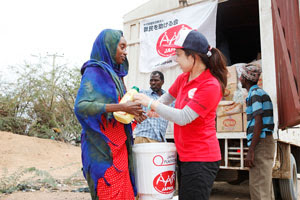According to a report made by the Turkish government on October 30th, over 600 people have been killed by the 7.2-magnitude earthquake that shook eastern Turkey on the 23rd. A relief team that was dispatched by AAR JAPAN, consisting of 3 staff members, arrived in Turkey on the 26th and is currently assessing the extent of the damages caused by the earthquake. Miyuki KONNAI reports from Erciş, one of the cities severely affected by the disaster.
Disaster Victims Gather at Temporary Clinics
 |
October 29th, 2011- Mr. Ates, who arrived in a temporary clinic in Ercis. He injured his leg in the earthquake. |
As we entered the Erciş district on October 29th, we immediately noticed the city covered in rubbles of collapsed buildings.
Two temporary clinics have been built in this area. We chose to visit one of these facilities, formerly a high school gymnasium, in order to investigate the effects of the disaster. Many patients begin to arrive at around 9am, some limping, some being carried in by their family members, and others transported by the ambulance. Everyday, doctors, patients, and the patients’ families crowd the gym-turned-clinic, which now even has “hospitalization tents”.
At the clinic, we met Mr. Rifat Ates (65 years old), who was getting his injured leg treated. As he was on his way home from the bakery, something struck his leg when the ground suddenly shook, leaving a 10-cm gash on his left shin. “Please wash your wound once a day with clean water, and don’t hesitate to come in if you feel even the slightest of pain,” the doctor told Mr. Ates, who said that the wound has significantly improved.
“My Sister Died.”
 |
October 29th, 2011- Humeyra broke her leg when the earthquake struck. She lost her older sister in the disaster. |
Around 9:30am, Humeyra Savci (5 years old), wrapped in a white blanket, arrived at the clinic carried in her father’s arms. Her left foot that poked out of the blanket was encased in a cast. As she sat down on the bed with her father, she waited for the doctor with a worried expression on her face.
“(My leg) was broken in the earthquake.” “My sister died.” Humeyra slowly described the day of the incident in a weak voice. When the earthquake struck, she was watching television in the living room while her sister, Houva (7 years old) was helping her mother cook in the kitchen. The cupboard suddenly tipped over and the oven fell. Houva got caught between two tables and died. Meanwhile in the living room, the television and the stove fell over and Humeyra broke her leg.
The Lives of Evacuees in Tents
The injuries of those who come to the clinic vary from burns to fractures. Medical aid was thought to be sufficient through the allocation of domestic doctors and nurses; however, if the evacuees continue to live in the tents, cold will spread, and a large number of people could also suffer from diarrhea. Next to the clinic, we saw about 200 tents that were set up by the Red Crescent Societies.
We have been continuing our investigation process, being inclusive of marginalized communities such as remote villages and schools for persons with disabilities, and beginning to prepare for the distribution of relief supplies.
* This project was made possible thanks to a grant provided by Japan Platform in addition to generous individual donations.
 |
October 9th, 2011- The city of Ercis filled with debris of destroyed houses. Yumeka OTA (center) of AAR JAPAN assesses the extent of the damages caused by the earthquake. |
 |
| October 29th, 2011- Adjacent to the clinic were tents set up along Lake Van. The green truck supplies Turkish chai tea. |
































